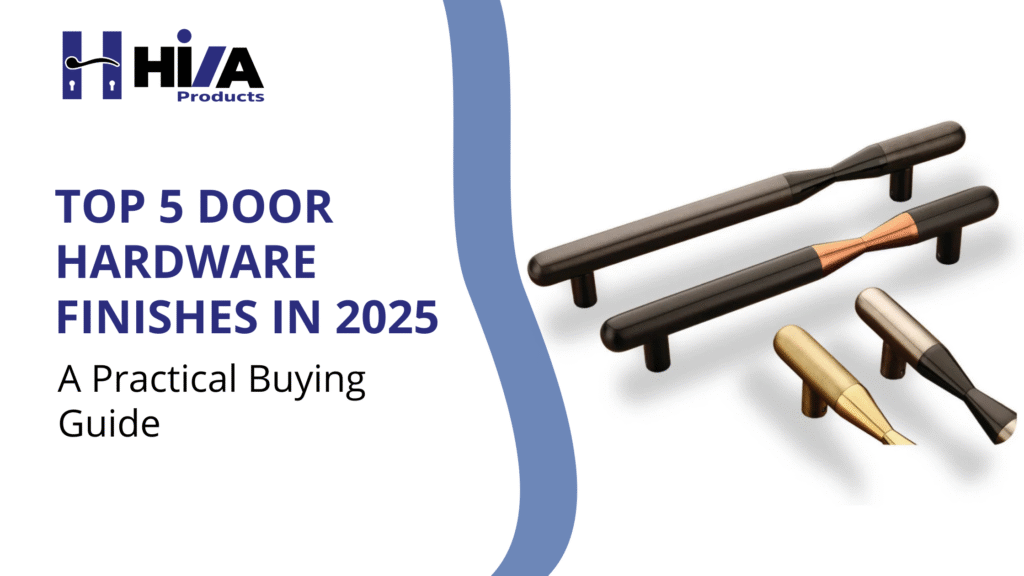Introduction: Why Finish Isn’t Just a Surface Detail Anymore
A handle may open a door, but its finish opens up perception. It’s what your fingers touch first, what your eyes register second, and what silently communicates quality long before words do. In 2025, hardware finishes are no longer an afterthought; they’re strategic design tools that express personality, signal intent, and influence how a space is perceived—whether that’s a hotel lobby in Mumbai or a compact apartment in Kochi.
More than ever, finishes must perform across aesthetics, climate resistance, and long-term durability. As global design becomes increasingly democratized, Indian consumers—especially entrepreneurs designing boutique spaces—are seeking finishes that align with both form and function. The result is a renaissance in hardware finishing, where metallurgy meets mood.
The Evolution of Door Hardware Finishes: From Utility to Signature Style
Historically, door hardware was purely utilitarian. In colonial India, iron and brass were the dominant materials, selected for availability, not aesthetics. But in the last two decades, finishes have evolved from industrial coatings to crafted expressions of lifestyle.
The turning point came with the rise of modular interiors and the influence of European minimalism. Suddenly, brushed steel wasn’t just durable—it was aspirational. Today, brands like Hiva Products are pushing the boundaries of finishing with proprietary blends, weather-tested coats, and artisanal textures that adapt to both coastal humidity and urban grime.
According to interior stylist Sarah Sherman Samuel, “A finish has the power to either elevate or flatten an entire design scheme. The wrong choice dates a room. The right one anchors it in time and taste.” And that brings us to what’s ruling 2025.
Finish Fundamentals: What Makes a Finish Durable, Desirable, and Distinct in 2025
Before diving into the top finishes, it’s important to understand what makes a finish truly viable in 2025—especially in the Indian context.
A good finish isn’t just about sheen. It’s about:
- Resistance to UV, humidity, and corrosion
- Compatibility with smart locks and frequent touchpoints
- Ease of maintenance and non-reactivity to oils, cleaners, and climate
- Aging gracefully (or intentionally patinating)
The Bureau of Indian Standards (BIS) has begun outlining performance thresholds for hardware coatings, with salt-spray resistance exceeding 96 hours now considered baseline for coastal zones. Meanwhile, anti-fingerprint and antimicrobial coatings are being adopted in post-pandemic design consciousness.
These technical demands filter down to one big question: Which finishes actually work for real-world users, not just in catalog photos?
Matte Black: The New Classic for Minimalist Spaces
There was a time when matte black was considered bold. In 2025, it’s baseline chic. The popularity of this finish has skyrocketed because it offers the ultimate neutrality without ever appearing bland. It works with industrial lofts, Japanese wabi-sabi, and even neo-deco interiors. And unlike glossy blacks, the matte version hides fingerprints, absorbs light beautifully, and complements textured walls.
In fact, a market report from the World Hardware Expo notes that matte black finishes have seen a 300% rise in demand since 2020, especially in high-end apartment complexes and co-living developments.
But here’s the catch: not all matte blacks are created equal. Low-grade powder-coated black can chip under heavy use. Hiva Products addresses this with multi-layer electrostatic finishes that add tactile depth and extended durability.
One designer quipped, “Matte black is the little black dress of hardware—understated, versatile, and endlessly relevant.”
Antique Brass: Timeless Character Meets Contemporary Edge
Once reserved for royal mansions and vintage restorations, antique brass is staging a modern comeback. But this time, it’s more nuanced—less yellow, more bronze-gray undertones, brushed to perfection.
Antique brass offers what few other finishes can: a sense of history without the burden of kitsch. In India, where cultural layering is already deep, this finish fits organically into both heritage homes and new builds looking for warmth without gloss.
More importantly, it wears well. The controlled patina over time enhances character instead of degrading appeal. As one hardware specialist put it, “Antique brass doesn’t age; it evolves.”
Hiva’s newer brass finishes use an oxidizing process stabilized with sealant layers to ensure both visual depth and consistent tone—especially crucial in India’s high-humidity zones.
Satin Nickel: Quiet Luxury That Works Everywhere
Satin nickel is the industry’s silent achiever. Neither shiny nor dull, it sits perfectly in that space of modern elegance. If matte black is bold and antique brass is soulful, satin nickel is sophisticated.
What makes this finish thrive in India is its understated compatibility. It looks just as good on a wardrobe handle as it does on a heavy-duty main door lever. It doesn’t scream for attention but always delivers on aesthetic value.
And while chrome tarnishes and polished brass yells, satin nickel whispers. According to Architectural Digest, “It’s the finish designers choose when they don’t want to fight with the room.”
Functionally, satin nickel resists fingerprints better than chrome and doesn’t oxidize like untreated brass. Hiva uses a vapor deposition method that fuses the nickel layer onto the substrate, creating a bond that resists scratches and chemical cleaners alike.
Graphite and Gunmetal: Dark Neutrals with Designer Swagger
Graphite is what matte black wears to a gala. Darker than nickel but less saturated than black, it walks the tightrope between moody and luxurious. Gunmetal takes it a step further by introducing a hint of blue or silver sheen.
Designers across Southeast Asia are increasingly using these shades to add weight to interiors without going fully monochrome. Think smoky hardware on pale oak doors or slate gray handles against teal cabinetry.
What elevates this finish is its tactile illusion. It often appears smooth from a distance but reveals a subtle brushed texture up close. It also hides wear marks and is highly forgiving of the occasional knock—making it ideal for commercial properties, upscale rentals, and boutique showrooms.
Hiva’s graphite range is specially developed to resist the reddish rusting that cheap imitations suffer from in Indian climates. Their internal testing benchmarks include 120-hour salt spray resistance and 10,000-cycle durability trials.
Dual-Tone Finishes: Blending Contrast for Visual Harmony
A relatively new entrant that’s poised to dominate 2025 is the dual-tone finish—a smart layering of two finishes on the same hardware component. Common combinations include matte black with brushed brass, or satin nickel with graphite.
Why now? Because modern interiors are no longer monolithic. Kitchens borrow from industrial aesthetics; bedrooms embrace mid-century hues. A dual-tone handle acknowledges these transitions, offering visual cohesion without uniformity.
These finishes also let homeowners hedge aesthetic bets. One recent buyer said, “I loved brass but didn’t want it to overwhelm the space. The black-and-brass handle struck the perfect balance.”
Hiva’s dual-tone collections are hand-assembled to ensure seamless blending and use electrochemical bonding for contrast layers that won’t peel over time. The craftsmanship shows: every piece becomes a focal point.
Regional Realities: Matching Finishes to Indian Climate, Architecture, and Use Cases
In a country as climatically diverse as India, a finish that thrives in Delhi might fail in Chennai. Coastal cities demand anti-corrosive coatings; dry zones favor dust-resistant textures. Meanwhile, heritage zones in Rajasthan might lean towards earthy antique finishes, while Bengaluru startups opt for clean graphite minimalism.
India’s urban homebuyers are also changing fast. The 2024 HVS Real Estate Insight noted that 63% of new urban homeowners aged 28-40 prefer darker, low-sheen finishes that mask wear and reflect a contemporary sensibility. That’s a seismic shift from the high-gloss obsession of the early 2000s.
Knowing the climate, usage frequency, and architectural language of your space isn’t optional—it’s foundational.
Maintenance & Longevity: What You Need to Know Before You Buy
Here’s the unsexy truth: beautiful finishes can turn ugly fast if you don’t consider upkeep. High-polish finishes may need weekly wiping. Brass demands polishing. Matte finishes? They hate abrasives but love microfibre.
Smart buyers ask:
- Will it stain from sweat or sanitizer?
- Does it react with tap water?
- Will it peel under friction from heavy bags?
That’s where Hiva’s anti-fingerprint, scratch-resistant, and weather-sealed coatings offer peace of mind. For entrepreneurs fitting out commercial spaces, this isn’t luxury—it’s insurance.
How Hiva’s Finishes Are Engineered for Indian Homes and Global Aesthetics
While global in design language, Hiva’s finish technology is hyper-local in its testing. Each product undergoes friction simulations, chemical exposure, and salt spray endurance before earning its label.
The goal? Finishes that last not just through seasons, but through trends. Whether it’s a dual-tone lever on a minimalist door or a satin nickel knob in a heritage bungalow, Hiva ensures that the visual and functional promise of the finish endures.
Conclusion: Choosing a Finish That Feels as Good as It Looks
In 2025, buying hardware isn’t just a fixture decision—it’s a design commitment. The right finish elevates the space, simplifies maintenance, and speaks to the user’s evolving taste.
From matte black’s sculptural subtlety to graphite’s confident restraint, from antique brass’s story-rich patina to the bold sophistication of dual-tones, the future of finishes is richly diverse and deeply intentional.
Choose wisely. Because in the end, a finish isn’t just what you see—it’s what you live with.

